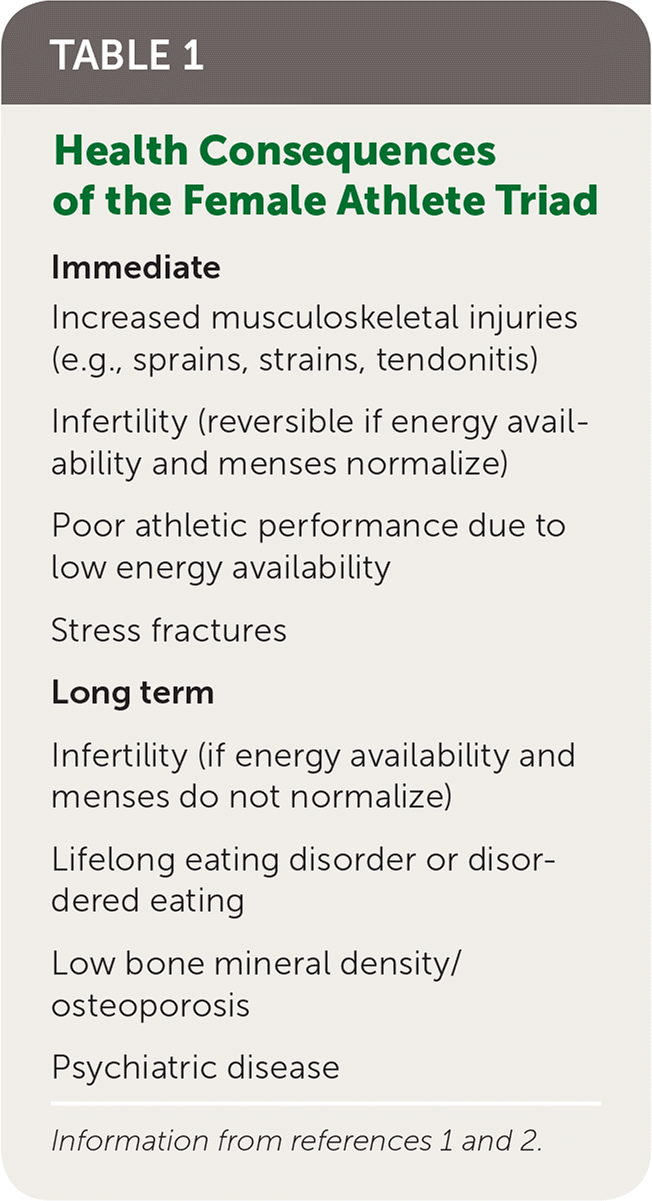
Am Fam Physician. 2018;97(8):499-502
Related letter: Broadening the Female Athlete Triad: Relative Energy Deficiency in Sport
Author disclosure: No relevant financial affiliations.
The female athlete triad was recognized in 1992 and is defined as a spectrum disorder of three interrelated components: (1) low energy availability due to disordered eating, eating disorder, or lack of nutrition relative to caloric expenditure; (2) menstrual dysfunction; and (3) low bone mineral density (BMD).1,2 Its advent has been linked to the increase in female athletic participation since Title IX passed in 1972.1–3 An international consensus group published updated recommendations on the female athlete triad in 2014.1 Family physicians should be familiar with these recommendations because prevention and early intervention can significantly reduce morbidity from this disorder.
The incidence of the female athlete triad is ill-defined because of patient reluctance in providing an appropriate history. Athletes at greatest risk are those who participate in sports that emphasize leanness (e.g., “aesthetic” sports such as cheerleading, gymnastics, and dance) and endurance (e.g., long-distance running, swimming).2 Data show that 36% of female high school athletes have low energy availability, 19% to 54% have menstrual irregularity, and 13% to 19% have low BMD. In aesthetic and endurance athletes, 10% to 15% have at least two components of the female athlete triad.4 The presence of even one component is concerning and should warrant further investigation.1
Immediate and long-term health consequences of the female athlete triad are listed in Table 1.1,2 The short-term consequences can be emotionally devastating to athletes.1 The largest accrual of BMD in females occurs during adolescence, and BMD peaks in late adolescence or early adulthood.1 Because the female athlete triad most commonly affects this age group, much of the loss of BMD accrual likely cannot be recovered.5 The long-term consequences of loss of BMD accrual in peak years are not fully known.5 Diagnosis of the female athlete triad can be difficult because features can be subclinical.1 Cultural attitudes about the female athlete's body image6 and low awareness of the disorder may prevent those affected from seeking help.7,8 There is a belief in certain sports that amenorrhea is a sign that the athlete has achieved a training ideal.6,7 Knowledge about the female athlete triad is low among school nurses, and only 47% of primary care physicians are aware of the disorder.3,9

| Immediate |
| Increased musculoskeletal injuries (e.g., sprains, strains, tendonitis) |
| Infertility (reversible if energy availability and menses normalize) |
| Poor athletic performance due to low energy availability |
| Stress fractures |
| Long term |
| Infertility (if energy availability and menses do not normalize) |
| Lifelong eating disorder or disordered eating |
| Low bone mineral density/osteoporosis |
| Psychiatric disease |
Screening female athletes for the disorder during the preparticipation examination is recommended. However, because data are limited on the effect of screening, family physicians should use their judgment on how to best spend time during preventive visits. A questionnaire is available to help identify at-risk patients such as those with a low body mass index, disordered eating, delayed or irregular menses, or history of stress fracture1; answers suggesting any component of the disorder warrant further investigation. Standard workup for amenorrhea is needed before functional hypothalamic amenorrhea can be diagnosed. BMD testing with dual-energy x-ray absorptiometry should be considered in patients with at least one high-risk criterion or at least two moderate-risk criteria.1
Nonpharmacologic management is first-line therapy for the female athlete triad, and a multidisciplinary team is recommended. Therapeutic goals are increased energy availability, weight gain, and resumption of normal menses. Athletes may need to restrict physical activity to increase energy availability. If a patient has poor knowledge of her energy expenditure and is not consuming enough calories, referral to a nutritionist/sports dietitian and/or exercise physiologist is recommended. Patients with disordered eating should be referred to a dietitian for nutritional counseling; these patients may also need psychological evaluation. Psychological treatment should focus on modifying unhealthy beliefs and behaviors related to food and body image. If a patient has a clinical eating disorder, reversal of low energy availability will likely require psychological therapy and nutrition counseling.1
Pharmacologic treatment should be considered only if a patient has not achieved eumenorrhea after one year of recommended therapy. Although oral contraceptives can falsely induce withdrawal bleeding, data have not shown that they improve BMD. If pharmacologic estrogen replacement is necessary because of worsening BMD with nonpharmacologic treatment, transdermal estrogen with cyclic progesterone may be considered in patients 16 to 21 years of age to prevent further bone loss. Bisphosphonates should be a last resort, and referral to an endocrinologist or expert in metabolic bone disease is needed in such cases.1
Family physicians are well positioned to educate patients, families, and coaches about the female athlete triad during preparticipation examinations and well-woman visits. Family physicians are often the first point of contact for women with amenorrhea and musculoskeletal injuries, both of which are associated with the female athlete triad. Although the benefits of regular exercise far outweigh the risks,5 the female athlete triad may negatively affect a significant number of female athletes. Family physicians can help change the culture in sports through improved detection of this disorder and educating patients and communities.
